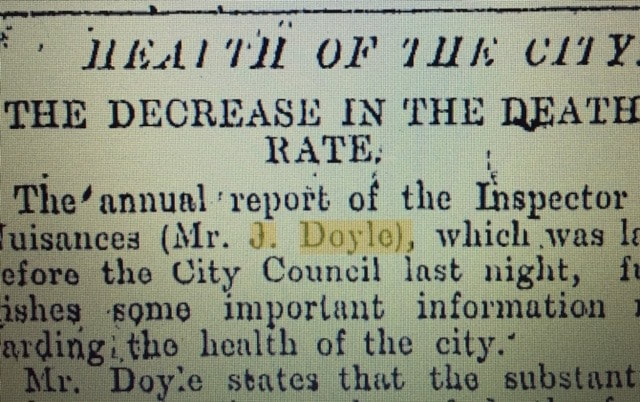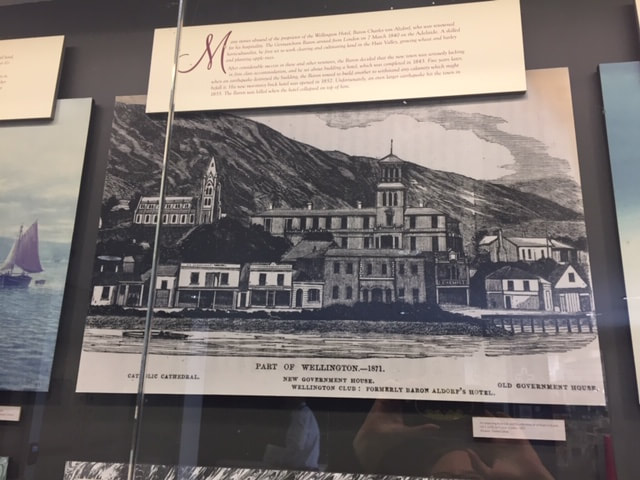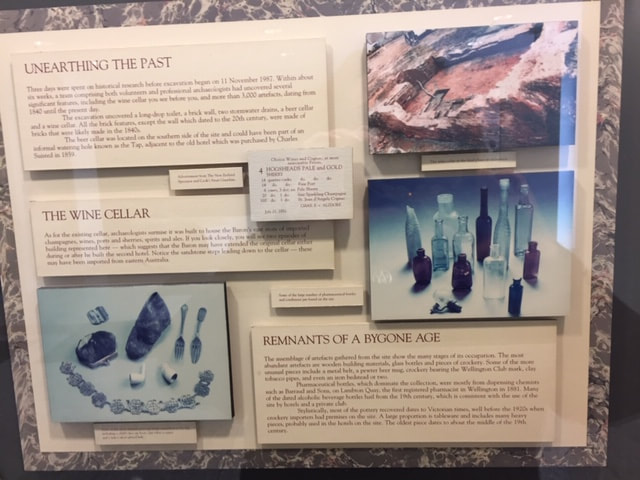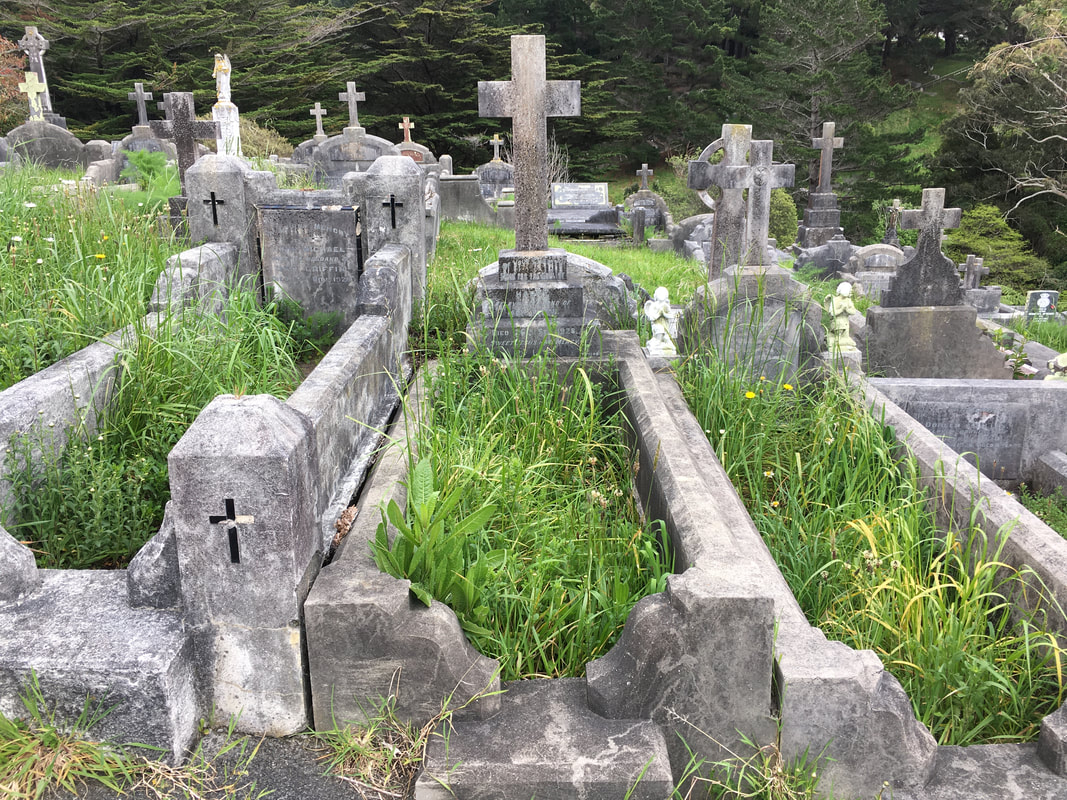|
In a quiet row of graves at Karori Cemetery is a little grave of a little girl whose name is barely remembered. But Elsie Marion Glasgow’s dog is a Wellington icon.
Her once faithful companion - originally called Dash - is now known as Paddy the Wanderer. He and Elsie used to go with her mother Alice to the waterfront to meet the ships bringing Elsie’s father John home. But when Elsie died at only three and a half years old from pneumonia in 1928, Paddy ran away and began wandering the waterfront. Despite attempts to settle him again, he never again had an ‘owner.’ He became famous for getting on coastal steamers and heading away only to return to make another trip. He became beloved by the watersiders and seamen who ensured his safety, making him an assistant night watchman whose job it was to keep guard for pirates, rodents and smugglers. As he aged he spent time with the tally clerk’s office. His adventures have been made into a book, a memorial, museum exhibits and every year the Wellington Museum pays for the Wellington City Council registration tag, put on the statue as a way to memorialize him. The Airedale terrier was a common sight on the waterfront and he was fed by the men who came to know him best. He had stowed away to Australia, sailed around New Zealand, rode the Wellington trams and became the first dog in New Zealand to fly in a plane. He wandered the streets, knowing how to cross a street once the light went green. He was awarded the freedom of the city in 1935. There were also rumours he made it as far as San Francisco. On his death in 1939 there was a funeral procession through the city including 12 black taxis who took him to the city crematorium. Now a brass plaque with a likeness of Paddy now sits on the waterfront with two drinking bowls for all good boys. And a permanent exhibit at the Museum of Wellington City & Sea displays a life sized statue of the dog that captured the hearts of Wellingtonians. Elsie herself - usually called Bubby - is buried at the Karori Cemetery. Her relatives still live in Wellington.
0 Comments
A terrifying explosion in the middle of the night during wartime would be a cause for panic anywhere.
It woke half of Auckland just after midnight in June 1942 but there was no headline, no explanation and no one spoke of it despite worry that the Japanese had invaded. It wasn’t until 1945 that the story of the death of 11 airmen from a plane crash became known. Wartime censorship had done its job to keep secret that a Flying Fortress plane - the first of its kind to reach New Zealand - had crashed into a low hill on farmland at the extreme end of one of Whenuapai airport’s runway. The plane called the Texas Tornado was in New Zealand on a secret mission. And on board has been 11 airmen, from the United States and one from France. The plane hit so hard it knocked a house almost apart and pieces were found for miles. Horribly, there were two immediate survivors, one man was seen dragging a comrade from the crash. He then returned to the plane for others but it burst into flames and within minutes two of the 500 pound bombs being carried exploded. Several days later a very quiet funeral was held at Waikumete Cemetery and the men were interred on June 21, with the then Minister for Co-ordination of Defence in attendance. Army and Navy men made up a silent honour guard. It took years before the names were mentioned, for the first time in the Auckland Star newspaper in 1945. And the worried parents and relatives of those killed spent months trying to get confirmation of what happened. A special part of the cemetery was set aside for them and they were reburied there until the end of the war when they were repatriated to America and buried with full military honours They were James Bruce, Charles Brunson, Curtis Childers, John Clanton, Richard Cobb, Harry Cohn, James Herriotts/Herriotta, E Hoffman, E Hurst, J Lopez and Free French Navy liaison Jesn Gilbert/Githerd. Ah Kirkcaldie and Stains, Wellington’s prestigious department store.
Home of the doorman who gave you a little bow, massive sales with huge queues, quality goods and bullets flying in the tearoom. Wait, what? Yep, that’s right, in 1898 there was an attempted murder at Kirks. It’s a story of stalking, corsetry, debt and a trial. On a quiet Thursday afternoon in October, Annie McWilliam spotted tearoom owner Ellen Dick just a few paces away from the counter, on the top floor of the store. Obsessed over a grudge, Annie stood and pulled out a six-chambered pistol and fired. Astonishingly Ellen’s corset saved her, the bullet ricocheting off the closely-spaced steel stays. But Annie wasn’t done. As Ellen ducked, she fired again and again. One closely missed a cook in the process of making scones. Bullets buried themselves in the walls of the tearooms. Other customers fled in terror. A shop walker grabbed Annie as she began to leave followed by Sydney Kirkcaldie, then a junior member of the firm, who took the gun away from her. Annie had been nursing a grievance against Ellen over a lawsuit about a hotel on the West Coast and had been noticed by Ellen at the tearooms several times. Annie was described as slightly built, about 49, of pale complexion with dark eyes. She was separated from her husband with a son and two daughters. She was understood to have mortgaged her home to provide the purchase money for the City Hotel in Reefton which Ellen was running. The hotel was later sold by the mortgagee. At the trial in the Supreme Court, Ellen said she had paid every penny of her salary as housekeeper toward liquidating her debt but that was never accepted by Annie. The short trial was contentious, Annie was warned many times by the judge about interrupting to call Ellen a liar. The debt was supposed to be over £2000, a huge sum for the time. Then suddenly only half a day into her trial Annie changed her plea to guilty and the jury discharged. She was given seven years imprisonment and hard labour at the Terrace gaol. Ellen, meanwhile, returned to work the day after the shooting. In a strange twist to the end of Annie’s story, she lived for many more years only to drown after falling from the Auckland ferry wharf aged 76. Annie Geraldine McWilliam (nee Mannix) is buried at the Hillsborough cemetery in Auckland. Do you think you have a rubbish job?
Spare a thought for the men who held the title of Inspector of Nuisances to various councils around New Zealand. Great title aside, they literally dealt with the rubbish of a city. Started in Britain, they were a type of sanitation and environmental health inspector, expected to deal with everything from dead animals in the street, night soil and a weird array of other problems. A quick search in Wellington City Archives and newspapers at the time show a vast number of complaints about things like horrible smells, dog taxes, unsanitary premises, gorse, cow sheds, loitering fruit sellers and even a case of leprosy. And proving that Wellington traffic problems have been around forever, the increase of motorcars and the speeds they traveled. (The first cars in New Zealand were imported into Wellington.) What a job huh? One of these men was James Joseph Doyle. Born in Williamstown, Australia in 1852 he came to New Zealand in 1868 attracted by gold but ended up in Wellington in 1879 where he went into the police force. He left the police in 1895 to become a muscular temperance lecturer for six months but then rejoined the police. Doyle became Inspector of Nuisances to the Wellington City Council, a role he developed into that of chief sanitary officer. He held the role until 1922. His term is marked by the reforms he made. Especially in regards to the prevalence of typhoid fever, an ever present threat. He is credited with helping prevent deaths. He was the first to suggest setting up municipal abattoirs and the need for a pure milk supply. At one point in his career in 1900 he was doing inspections for bubonic plague. He prosecuted people for selling diseased meat and in one annual report was able to happily report that spitting on the sidewalk had decreased probably due to a £20 fine. He was noted for literally sniffing out problems. He was also a noted athlete, a runner and heavyweight lifter. Mr Doyle died aged 76 in 1926 after serving his city loyally for many years. Flags on the municipal buildings were flown at half mast for him. He is buried at Karori Cemetery. With thanks to Wellington City Archives for their amazing resource. Grave Story #6 The earthquake that forever changed how Wellington looked also killed one of its most colourful citizens. Baron Charles Ernest von Alzdorf had come to New Zealand in 1840 and bought land in the Hutt Valley but he preferred his grand new hotel on Wellington’s waterfront to being a farmer. It had been standing in the earthquake of 1848 and had some damage before being rebuilt to two storeys. Von Alzdorf boasted about The Wellington hotel built of brick and plaster. He was justly proud of it, complete with European facilities like a steam bathhouse, one room with a vapour bath. It was flash and new and the Premier at the time Henry Sewell called it quite the most pretentious building New Zealand had yet seen. The Baron had derided the other buildings in Wellington built of wood. He thought brick was the way to go. It would be fatal. He had not learned the lessons that Wellingtonians had learned only seven years before when a series of earthquakes all but destroyed 80 brick and stone buildings leaving the wood ones standing. On January 23, 1855, a massive earthquake struck Wellington and the Wairarapa area. The Baron, who had had a stroke a couple of months earlier, had been sitting before a fire and a portion of the wall with the chimney on it fell in on him. His son Walter and wife Mary were at their home in Lower Hutt. The earthquake set the standard for powerful shakes, registering as 8.2 and originated on the Wairarapa fault and generated a tsunami in Cook Strait. About 250 aftershocks were felt in the following hours. His name is the only one readily found as being a fatality of the quake in news stories of the day. Several Maori died in Wellington and the Wairarapa, many when a building collapsed on them, but reports from the time don’t name them. The Baron is buried in Bolton Street Cemetery, however his precise whereabouts is unknown. This was, unusually, at his own request that there be no marker on his grave and that it be near his friend, Colonel William Wakefield who had died only shortly before him at the Baron’s hotel. The destruction of Government buildings and banks built with brick led to a revolution in building in Wellington.
The Old Government building - now the Victoria University Law School - began in the 1870’s. Now a heritage site, the lesson had been well and truly learned. But it wasn’t just the buildings, the Basin Reserve, formerly a swamp, began to drain, the coastline around Porirua was raised and thousands of miles of land in East Wellington were raised by several metres. The remains of von Alzdorf brick-lined wine cellar have since been found in Bowen House. A display shows bricks from the cellar along with bottles recovered. His only son Walter married and moved to Foxton where he died, leaving a large family. Their descendants are spread around New Zealand. The grave of Robert Bradford Williams at Karori Cemetery, Grave Story #5 Well ahead of America electing its first black American woman and south Asian Vice President, Wellington’s Onslow Borough had an African American mayor.
The extraordinary story behind Robert Bradford Williams and his journey from pre-civil war Georgia in the United States to a highly respected statesman in New Zealand began in 1860. It was the year Abraham Lincoln was elected president and America was on the verge of civil war. Williams, who may not have been a slave himself, but whose grandparents or parents could have been, was born in Augusta, Georgia. He received a private school education and went to Yale University where his singing voice was noticed along with his athletic prowess. He joined the Fisk Jubilee Singers, a group formed out of Fisk University which had been set up to provide university level education to freed slaves and other young African Americans. It would take him on a world tour in 1886 that led to New Zealand. Williams married white Catholic girl Katherine Burke in Tasmania and they made their home in Wellington. He needed a career and began training to be a lawyer. The papers of the time became filled with his cases, from prosecuting animal cruelty (he was a supporter of the SPCA), his defence of criminals, employment cases and inquests. Just as many mentions were made of his singing, with various organisations. In 1902 he successfully stood for mayor of the Onslow Borough, a post he returned to unopposed many times. Instead of returning to local politics in 1907, he stood for the general election in 1907 and again in 1914 but was not successful. He died in Otaki in 1942 and is buried in Karori Cemetery with his beloved wife Katherine. At the time of his death, he had three adult children and several grandchildren. Many of his descendants still live in New Zealand. His story can be heard https://www.wcl.govt.nz/downloads/janepaulmono.mp3 in the voice of his granddaughter Jane Paul as told to Gábor Tóth, Local & NZ History Specialist for Wellington City Libraries. Grave of Harry and Johanna Tyson (centre) at Karori Cemetery. Grave Story #4 This unremarkable grave in Karori Cemetery in Wellington is the final chapter in the lives of two people who escaped the hangman’s noose and who may have got away with a double murder. Interred in this grave are Harry and Johanna Tyson, but these were not the names they were using when they were charged with the poisoning murders of their illegitimate twin sons. Back then, in 1898 in Hastings, they went by the names of Charles Henry (or Edward) Tyson and Elizabeth Rosa Moran. Charles (whose nickname was Harry) was a barman at the Railway Hotel. The couple did not live together, with Elizabeth staying at a boarding house nearby with the twin boys. This intriguing case began on Sunday, March 27, 1898 when the first of the three-month of twin boys, Charles Reginald Moran, was found dead in his bed. Two days later, on March 29, Elizabeth awoke to find Charles Reginald’s twin, Francis Milton Moran, also dead. March 29 was a very busy day for Elizabeth and Charles. Curiously, after finding Francis dead that morning, the couple proceeded to get married, before they attended the inquest on little Charles, and then later in the day appearing in court facing charges of murder. At the inquest, medical examiner Dr Robert Nairn gave evidence that the post-mortem had revealed Charles was a well-nourished and healthy boy except that his tongue, oesophagus and stomach showed considerable evidence of a strong corrosive poison. The jury returned a verdict that the boy had died by corrosive poisoning, but by whom it was administered there was no evidence to show. The next day, March 30 was also a busy day for the pair. That day they again appeared in court facing the charge of murdering Charles before they attended the inquest on Francis’s death. Dr Nairn testified that he had examined the boy’s internal organs, which he presented to the court in glass jars labelled Exhibit A and Exhibit B, and had found no obvious cause of death. It was decided to adjourn proceedings till both children’s organs could be analysed. The jars were carefully shipped off to the Government analyst in Wellington in the care of Constable Butler, leaving the Tysons on tenterhooks in Napier Gaol and the readers of Hawke’s Bay’s newspapers on the edges of their seats. At 7.30pm on April 5 the doors of Hastings Court were opened for the resumption of the inquest and, according to the Hastings Standard, a rush of people reminiscent of the “crush at the pit door of a theatre on a first night’s performance” ensued. A hush fell over the court as a police officer read a telegram from the Government analyst. “No poison found in children’s exhibits.” The public gallery broke out in applause. The Tysons were hurriedly released on bail on the murder charges and two days later the charges were dismissed. But what did cause the deaths of two seemingly healthy twin boys? Could it have been natural causes or some disease? Or was it just that toxicology was not advanced enough in 1898 to detect the possible poison or poisons used? We may never know. This was not the last time that the Tysons were involved in controversy. In February 1908 Charles and Elizabeth, who was now calling herself ‘May’ took over the management of the Upokongaro Hotel on the Whanganui river. In March 1910 residents of Upokongaro were awoken to a terrific explosion. All of the windows of the hotel had been shattered when a forestry contractor named George Laurent had attempted to blow up the hotel with two sticks of gelignite. He had committed suicide but left a note saying he had intended to kill Charles and May and May’s brother Gerald Moran over some undisclosed grievance. By 1912 the Tysons had moved to Kelburn in Wellington. Charles died in September 1928 and is buried in Karori Cemetery under the name Harry. Elizabeth died in July 1952 and is buried under the name she was given by her parents when she was born in Waterford, Ireland in 1873, Johanna. George Barclay's grave at Karori Cemetery. We at Genealogy Investigations love a good mystery, so of course we couldn’t resist doing a little investigating when Wellington City Council Archives last week posted a spooky picture of the grave of one George Barclay and a plea for any information about him.
Well, why wouldn’t we help with a bit of genealogy research? It is, after all, what we do! And it turns out Mr Barclay was a pretty interesting chap. George McIntyre Barclay was born in 1887 in Reefton to Elizabeth Louisa and Joshua Barclay. He was actually the second of their children to be named George McIntyre, the earlier one was born in 1885 and died three weeks later. In 1915 George was living in Wellington and was working for the Wellington City Council (or its equivalent back then). In October that year he signed up for service in WWI. His enlistment papers revealed that his occupation was a miner, which makes one wonder what kind of mining the council was involved in. At the time of his enlistment, George was living at 9 Princess Street Wellington and gave his next of kin as his brother Thomas Barclay of Fern Flat, Buller (their mother Elizabeth had died in 1894 and his father had died in 1906). He was described as being 5 feet five inches tall weighing 144 pounds with brown hair, blue eyes and of dark complexion. He also had a scar on his left cheek. George commenced duty on 9 October 1915 as a sapper in the New Zealand Engineer Tunnelling Company (the company is commemorated in Wellington by the Arras Tunnel under what was once Buckle Street). George completed his initial training in Avondale, Auckland and on 18 December 1915 embarked to England on the SS Ruapehu. On February 3, 1916 he marched into the Company Training Camp in Falmouth, England and just over a month later, on March 9, he embarked for France. On March 16 the company joined the underground warfare in the North of France. Two months later, on May 16, 1916 he was admitted to hospital due to the effects of gas. By 25 May he had sufficiently recovered to return to his unit. In 1918 he was promoted to the rank of Lance Corporal and by the time he was discharged, on 12 April 1919, he had served three years and 87 days in Europe. On discharge he first went to Taihape and then around 1922 he returned to Wellington, living in Hanson Street. George married in 1922 to Florence Emma Wood (1897-1989). The couple had at least two children: Agnes, born about 1924 and Raymond, born about 1935. George died on 26 December 1946 and was buried in Karori Cemetery. At the time of his death George was living in Agra Crescent in Khandallah and according to the electoral roll was working as a “chainman” for the Wellington City Council. Council's own employment records show he was promoted to assistant surveyor in 1937. He had worked for the council following his return from the war since at least 1928. Florence died in 1989 and is buried with George. The mystery of George Barclay was solved, but one further mystery remains … what is it that a “chainman” does? Here’s a link to some of the other spooky things in WCC’s archives. Photo: Wellington City Council, photographer Harold Falkner. Wellington City Council Archives, 00206-104 |
AuthorFran and Deb's updates Archives
May 2025
Categories |











 RSS Feed
RSS Feed